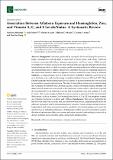| dc.description.abstract | Background: Aflatoxin, produced by Aspergillus flavus and Aspergillus parasiticus fungi, contaminates a broad range of crops such as maize, nuts, and cotton. Aflatoxin exposure causes growth failure, immune suppression, and liver cancer. While several systematic reviews have assessed the link between aflatoxin exposure and growth development in humans, there is a lack of reviews on the associations between aflatoxin exposure and micronutrient levels/status. This review addresses that gap by compiling studies on the association between aflatoxin exposure and micronutrient levels/status in humans. Methods: A comprehensive search of the SCOPUS, PUBMED, EMBASE, and Web of Science databases was conducted, focusing on studies published between 2003 and 2023. Only English-language studies using urine, blood, serum, or plasma biomarkers were included to assess the exposure and outcomes. The risk of bias in these studies was evaluated using the Academy of Nutrition and Dietetics Quality Criteria for human studies. Results: Ten observational studies were included in the systematic review, which collectively reported the association between aflatoxin exposure and haemoglobin, zinc, and vitamin A, E, and C levels. This review suggests that aflatoxin exposure is associated with micronutrient deficiencies, such as anaemia (low haemoglobin levels (<11 g/dL)) in pregnant women and vitamin A deficiency in adults and children. Conclusions: This review highlights the link between aflatoxin exposure and micronutrient deficiencies, emphasizing the need for aflatoxin mitigation within micronutrient interventions. Future studies should focus on longitudinal and interventional research to establish causal relationships and assess the effectiveness of mitigation strategies. Additionally, further research is needed to explore the interaction between aflatoxin exposure and other potential confounding factors such as dietary patterns, socioeconomic status, and genetic predisposition. | en_US |

